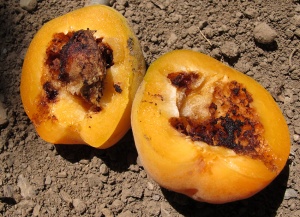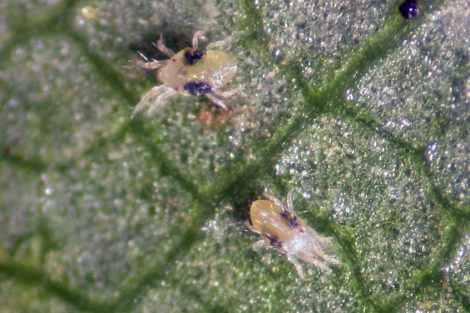In this Issue
- Apple, Pear: codling moth updated dates, woolly apple aphid, blister mites
- Peach, Apricot, Plum, Walnut: peach twig borer updated dates, greater peachtree borer, walnut husk fly
- All Fruits: spider mites
- Berries: prune out raspberry horntail damage
- Beneficial Spotlight: damsel bug
APPLE, PEAR
Codling Moth
View a pdf of the spray timing table. Be sure to read the instructions at the top of the page, for how to read the table.

Codling moth in most sites in northern Utah will begin second generation egg hatch in mid to late July. To prevent resistance to pesticides, we recommend switching to a different chemical class for the second generation treatment. The spray can occur at the start date shown on the codling moth table, or if you can tolerate higher injury or have a low population, protect the fruit just during the “peak egg hatch” time period.
Continue to protect fruit until harvest or September 15, whichever is earliest.
Keep in mind that the end of the first generation egg hatch is a great time to assess your codling moth control.
Commercial orchards should examine 5-10% of the fruit, and residential growers should check as many fruits as possible. Do not neglect fruit at the top of the tree where sprays may not have reached, or where residual insecticide may have broken down more quickly due to higher UV exposure.
A successful codling moth entry will show frass (sawdust-like excrement) pushed out of the apple at the entry hole. Most first generation entries are through the calyx end because, while fruit is still firm, it is easier for the larvae to enter at that location. Although not as common, side entries can also be found now, usually where two fruit touch or where leaves touch the fruit.
A codling moth sting is a small brown blemish on the fruit where the codling moth larva did not successfully enter the fruit, either because it was killed, or it moved to a different spot. Stings from first generation are usually not as noticeable at harvest.
If you cut into the fruit to look for the larva inside, you can sometimes tell when control failed. If larvae are large or there is no larva in the fruit, then the entry occurred approximately near the beginning of egg-hatch.
Medium-sized larvae (1/3-2/3-inch long) indicate that entry occurred at the early to mid egg-hatch period (early June), and if the larvae are small, they entered in late June. If you are finding a lot of damage, evaluate your management program to improve control for the second generation. Consider the material used, the spraying method, and the length of time between treatments.
Woolly Apple Aphid

Woolly apple aphid overwinters as nymphs on apple roots or in protected sites in the tree. Deep frosts will kill overwintering nymphs in the canopy. Aphids start activity in spring (females give birth to live nymphs), but they are not visible in the canopy until early to late June.
Young nymphs will crawl to new feeding sites (or are blown by the wind) as the season progresses to start new colonies. Older stages are less mobile.
They look like tufts of cotton due to their waxy excretions, but if you touch the colony, it is very sticky. Some aphids remain on the apple roots while others colonize parts of the canopy.
Woolly apple aphids are the most difficult aphid to manage due to their waxy protection and overwintering habit on the roots.
Treatment
- Residential growers can use insecticidal soap plus 1% oil, aimed directly at the colonies. Ortho Flower, Fruit and Vegetable (acetamiprid) plus 0.5% oil is also effective.
- Options for commercial growers: click here.
Blister Mites
Many people are asking about leaf spots that looks like a disease. They are actually blisters, and inside each one are hundreds of microscopic mites.
The 4-legged mites feed inside the blisters all summer. On apple leaves, the blisters age to brown, and on pear leaves, they age to a dark brown/black.
After harvest, the mites leave the blisters and migrate to leaf buds to spend the winter.
Note that there is nothing to do for treatment at this time of year, but an application after harvest and close to leaf drop will help. Materials include Sevin (carbaryl), sulfur, or oil.
PEACH/NECTARINE, APRICOT, PLUM, WALNUT
Peach Twig Borer
View a pdf of the spray timing table. Be sure to read the instructions at the top of the page, for how to read the table.

Second generation egg hatch will begin in a few weeks at most locations. In high-population areas, two cover sprays may be required. In low population areas, only one application is needed.
Pay attention to apricots, which ripen earlier. At this time of year, peach twig borer larvae will be entering fruit as they ripen.
Greater Peachtree Borer

Continue to protect the lower 12-18 inches of trunk for peach/nectarine, apricot, and plum through September.
Make sure the spray covers the entire surface area, particularly close to ground level, and any exposed roots.
Young trees can be killed when trunks are girdled by feeding; older trees are weakened and become susceptible to attack by pathogens and bark beetles.
Treatment
Materials for home growers include:
- Hi Yield Permethrin (apply once/month)
- Spectracide Triazicide (apply every 3 weeks)
- organic options are spinosad and pyrethrum (apply every 7 to 10 days)
Other ways to prevent attack are:
- Remove all weeds, grass, and excess soil from around the base of the tree. Heat and dryness reduce the survival of eggs and larvae.
- Avoid mechanical and rodent-caused injuries to trunks.
- Keep trees healthy with optimal nutrition and irrigation.
Walnut Husk Fly

According to the walnut husk fly model, protection of walnuts (plus apricots and peaches near walnut plantings) should begin at these times:
- Most areas of Wasatch Front: July 15
- Cooler areas (Benches, Cache, Carbon, etc.): July 20 – Aug 1
The peak fly emergence will occur approximately three weeks after the start timing, so another application will be needed at that time.
Walnut husk fly is typically a pest of walnuts, but can attack soft apricots or peaches growing near walnuts.
The adult walnut husk fly has one generation per year. They overwinter as pupae in the soil and emerge as adults from mid-July until September. The female inserts eggs in groups of about 15 below the surface of the husk. The maggots feed on the husk for 3 to 5 weeks and then drop to the ground to pupate several inches below the soil.
On infested walnuts, the husk will be soft and black while the outer skin remains intact. The kernel is only affected if infestations start early in the season, which causes nuts to shrivel and turn moldy. Nuts are unharmed during late infestations (late August – Sept.), but hull removal becomes difficult.
Populations of walnut husk fly can be reduced by removing all nuts that fall to the ground. To make husk removal of infested nuts easier, store them in a damp burlap bag for 2 to 3 days.
Treatment
Applications you are making for peach twig borer (options are the same as for codling moth) will also target walnut husk fly on peach and apricot.
Spinosad (many brands) is one of the few options labeled for backyard walnut trees. Continue every 7 days up until one month before harvest.
ALL FRUITS
Spider Mites
So far, spider mite activity has been low on apples, peaches, and cherries in northern Utah. With the onset of the hottest days of the summer, their populations will start to spike in the next few weeks.
Check for mites by examining the leaves on the lowest branches first. (Mites overwinter in ground-cover and migrate up the tree in hot, dry weather.) Look for leaves that are stippled, and turn them over. Using a hand lens, look for the slow-moving mites.
Before making a decision on whether to treat, also look for predatory mites within the pest mite population. These are fast-moving mites, about the same size, that can prevent spider mite densities from exceeding economic thresholds. If predators are present, then a treatment may not be necessary.
A 0.5-1% application of horticultural oil is very effective on mites, especially when populations are low, and when the spray coverage is good enough to cover the undersides of the leaves.
Other options for spider mites can be found by clicking on the appropriate fruit: apple, peach, cherry.
Treatment
A 0.5-1% application of horticultural oil is very effective on mites, especially when populations are low, and when the spray coverage is good enough to cover the undersides of the leaves.
Spider mite options for commercial growers. (Select crop, and then select “fruit present” stage.)
SMALL FRUITS
Raspberry Horntail


Raspberry fruits are in various stages of maturity in northern Utah. Damage from the raspberry horntail has been visible for a few weeks now.
Now is the time to prune out the wilted upper portions of the canes and destroy the prunings (or kill the larva inside). This will help to reduce the horntail population in your area. When pruning, note that the white larva might be farther down the stem than you think. To get a feel for where the larvae are feeding, slice a few cut stems vertically to locate the larva.
Where there is no borer, the pith will be creamy-white. A pith with loose brown material will indicate borer activity.
BENEFICIAL INSECT SPOTLIGHT – DAMSEL BUGS

Damsel bugs are elusive and rarely seen, and move rapidly when disturbed. Although they are not a significant predator in fruit orchards, they can contribute to biocontrol of ground-dwelling insects such as beetle larvae, spider mites, and other insect eggs. They appear later in the season than other predators; starting in mid-summer.
Adults are tan-colored with long, thin bodies, slender head, and long antennae. Nymphs may resemble ants. This generalist predator actively seeks out prey, pierces it with needle-like mouthparts and sucks up the body contents.
It is often associated with meadows, pasture, alfalfa and other field crops. It is conserved by reducing tillage and maintaining mixed plantings.





